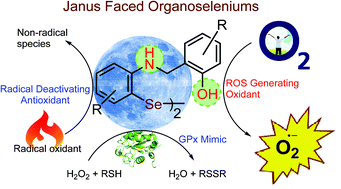Janus -faced oxidant and antioxidant profiles of organo diselenides†
Abstract
To date, organoseleniums are pre-eminent for peroxide decomposition and radical quenching antioxidant activities. On the contrary, here, a series of Janus-faced aminophenolic diselenides have been prepared from substituted 2-iodoaniline and selenium powder using copper-catalyzed methodology. Subsequently, condensation with substituted salicylaldehyde afforded the Schiff base, which on reduction, yielded the desired substituted aminophenolic diselenides in 72%–88% yields. The generation of reactive oxygen species (ROS) from oxygen gas by the synthesized aminophenolic diselenides was studied by analyzing the oxidation of dichlorofluorescein diacetate (DCFDA) dye and para-nitro-thiophenol by fluorescence and UV-Visible spectroscopic methods. Furthermore, density functional theory calculations and crystal structure analysis revealed the role of functional amine and hydroxyl sites present in the Janus-faced organoselenium catalyst for the activation of molecular oxygen, where NH and phenolic groups bring the oxygen molecule close to the catalyst by N–H⋯O and O–H⋯O intermolecular interactions. Additionally, these functionalities stabilize the selenium-centered radical in the formed transition states. Antioxidant activities of the synthesized diselenides have been explored as the catalyst for the decomposition of hydrogen peroxide using benzenethiol sacrificial co-reductant by a well-established thiol assay. Radical quenching antioxidant activity was studied by the quenching of DPPH radicals at 516 nm by UV-Visible spectroscopy. The structure activity correlation suggests that the electron-rich phenol and electron-rich and sterically hindered selenium center enhance the oxidizing property of the aminophenolic diselenides. Janus-faced diselenides were also evaluated for their cytotoxic effect on HeLa cancer cells via MTT assay, which suggests that the compounds are effective at 15–18 μM concentration against cancer cells. Moreover, the combination with therapeutic anticancer drugs Erlotinib and Doxorubicin showed promising cytotoxicity at the nanomolar concentration (8–28 nM), which is sufficient to suppress the growth of the cancer cells.



 Please wait while we load your content...
Please wait while we load your content...